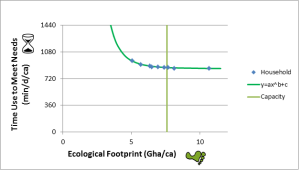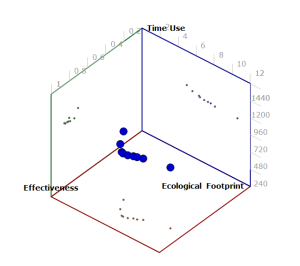In all economic transactions, the value of a product or service is perceived by the vendor to be less than the selling price, while the value perceived by the buyer is greater than the selling price. Or rather than the price, the value of the money equal to the selling price, although that distinction is not truly relevant.
But then, it is asked, what is the value of ‘Green’? Or, what is the value of the ecological systems that surround us and provide us with ecological benefits?
As there is no vendor, there is no value to the vendor, and thus the selling price may be zero. In the concept of Environmental Economics, the ‘Government’, as the steward of The Commons, is able to set a price that reflects the price of those environmental benefits. Of course, the concept also assumes the government is effectively omniscient, omnipotent, and wise, three conditions that are not supported by the evidence.
Likewise, there really isn’t a buyer. Why would you pay for air? No one can stop air from reaching me for free. But imagine if one could, then I would pay anything I owned to get my next-to-last gasp.
So, in the case of a commodity such as air, the value is less than the selling price, which is therefore nothing, and also greater than the purchase price, which could be anything. The concept of value must be uncoupled from price for at least some environmental features.
Perhaps value of the environmental feature can be estimated from a replacement cost. Thus, while I can’t estimate the value of sunlight, I can estimate the economic value of providing a similar quantity of heat and light. But that only works when there is a technological replacement for that environmental feature. So, while the case study of the New York City water supply would suggest that clean land will save about 0.5 cents/acre/ca., some environmental features cannot be replaced.
{New York Water supply case: The US EPA ordered the City of New York to upgrade its water treatment plant to the tune of an extra $8 B, plus $300M per year. The City chose instead to institute $2 B of stewardship programs in the upstream watershed, and provided the same water quality benefit. That worked out to an up-front savings of $50,000 per acre, divided through 10M people, or about 0.5 cents per person per acre, not considering the operational savings.}
This introduces a concept that usually would have no place in a discussion of economic value. There are environmental features that cannot be replaced by current technology, are not avoidable or controllable, and are therefore not buyable or sellable. Thus, the only value they could have is measured by the cost of their absence. So, what is Gravity worth? If Gravity ceased to operate tomorrow, there would be no life on the planet by the end of the day. So arguably, the value of Gravity is infinite. Rather than that, I would introduce the concept of ‘Sacred’ – any feature that is not replaceable, not avoidable/controllable, and/or not sellable, is Sacred, and cannot have a value that can be measured in something as vulgar as money.
For example, sunlight, by that definition, is Sacred. Even if the fraction of the Sunlight that goes to photosynthesis is considered, it is effectively Sacred, as there is no way to replace it. If this is pared down further to the sunlight that is used to produce food, the economic value is so large (eg, all economic activity on the planet has the same value as all food production on the planet, since we all work for food) that it is effectively Sacred, even if it doesn’t precisely meet the definition (replaceable, just not at that scale).
Weather is Sacred – it moves energy, air, and water around the globe, in a way that cannot be replaced, controlled, or sold. It may be that HAARP attempts to make weather mundane, but that is just conjecture.
Wilderness is Sacred, even if the term of Wilderness is somewhat ill defined and subjective.
This list is quite abbreviated, but it is clear that one could find many environmental features that meet the concept of Sacred. This illustrates that there is a need for the concept, and that there is a weakness in any financial argument, because many ‘things’ have some very high intrinsic values that cannot be reflected in financial terms. Another unit of measure is required.
So, I will introduce another concept. Natural Services are processes that reduce the amount of time required for communities to meet their needs, without an investment of time and/or resources on the part of the community. Thus a volcano adding ash to soils, and thus increasing crop productivity, is a natural service. Weather, sunlight, tides, etc all are natural services. Natural services renew renewable resources, assimilate wastes, and in many other ways allow people to live on the world in relative comfort, because we gain disproportionately to the effort required to utilize these services.
The value of the natural service is, at an absolute minimum, the replacement time cost for the community to either do without the natural service, or to substitute the natural service with an alternative. In many cases, the natural service will not be replaceable or avoidable and is therefore Sacred. This does not invalidate this argument, rather it demonstrates that some things are not and should not be for sale.
Thus, the value of ‘Green’ is, at a minimum, the aggregate time cost of the incremental absence of the natural services associated with ‘Green’. Due to synergistic effects, this apparent value must be conservative, and possibly very much so.
To compare to monetary values, one would have to add the life-cycle time benefit of the ‘Green’, and produce the financial cost to purchase this much time in the community. So, if a particular ‘Green’ feature saved the community 20 minutes per day per person, the economic value of the feature is 20 minutes of labour per day per person, multiplied by the value of each minute of that labour and the population affected. And this would be making the assumption that we understand the ecology sufficiently and the functioning of the community sufficiently to include all time costs accurately.
Understanding the value of ‘Green‘ is the first step in exploring Sustainable Technological Development.

